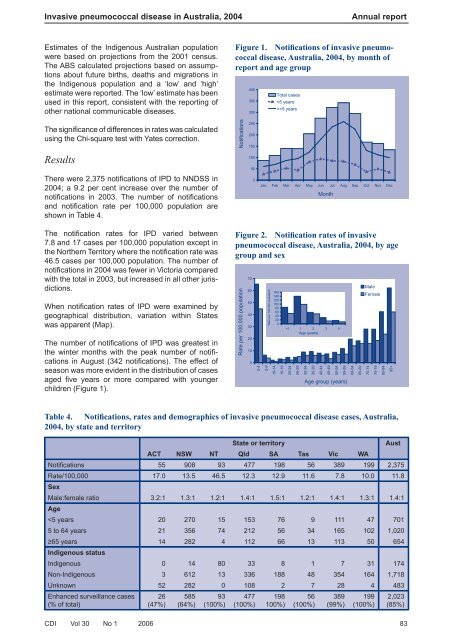PDF file - Department of Health and Ageing
PDF file - Department of Health and Ageing
PDF file - Department of Health and Ageing
You also want an ePaper? Increase the reach of your titles
YUMPU automatically turns print PDFs into web optimized ePapers that Google loves.
Invasive pneumococcal disease in Australia, 2004<br />
Annual report<br />
Estimates <strong>of</strong> the Indigenous Australian population<br />
were based on projections from the 2001 census.<br />
The ABS calculated projections based on assumptions<br />
about future births, deaths <strong>and</strong> migrations in<br />
the Indigenous population <strong>and</strong> a ‘low’ <strong>and</strong> ‘high’<br />
estimate were reported. The ‘low’ estimate has been<br />
used in this report, consistent with the reporting <strong>of</strong><br />
other national communicable diseases.<br />
Figure 1. Notifications <strong>of</strong> invasive pneumococcal<br />
disease, Australia, 2004, by month <strong>of</strong><br />
report <strong>and</strong> age group<br />
400<br />
350<br />
300<br />
Total cases<br />
=5 years<br />
The significance <strong>of</strong> differences in rates was calculated<br />
using the Chi-square test with Yates correction.<br />
Results<br />
There were 2,375 notifi cations <strong>of</strong> IPD to NNDSS in<br />
2004; a 9.2 per cent increase over the number <strong>of</strong><br />
notifi cations in 2003. The number <strong>of</strong> notifi cations<br />
<strong>and</strong> notifi cation rate per 100,000 population are<br />
shown in Table 4.<br />
Notifications<br />
250<br />
200<br />
150<br />
100<br />
50<br />
0<br />
Jan Feb Mar Apr May Jun Jul Aug Sep Oct Nov Dec<br />
Month<br />
The notifi cation rates for IPD varied between<br />
7.8 <strong>and</strong> 17 cases per 100,000 population except in<br />
the Northern Territory where the notifi cation rate was<br />
46.5 cases per 100,000 population. The number <strong>of</strong><br />
notifi cations in 2004 was fewer in Victoria compared<br />
with the total in 2003, but increased in all other jurisdictions.<br />
When notifi cation rates <strong>of</strong> IPD were examined by<br />
geographical distribution, variation within States<br />
was apparent (Map).<br />
The number <strong>of</strong> notifi cations <strong>of</strong> IPD was greatest in<br />
the winter months with the peak number <strong>of</strong> notifi -<br />
cations in August (342 notifi cations). The effect <strong>of</strong><br />
season was more evident in the distribution <strong>of</strong> cases<br />
aged fi ve years or more compared with younger<br />
children (Figure 1).<br />
Figure 2. Notification rates <strong>of</strong> invasive<br />
pneumococcal disease, Australia, 2004, by age<br />
group <strong>and</strong> sex<br />
Rate per 100,000 population<br />
70<br />
60<br />
50<br />
40<br />
30<br />
20<br />
10<br />
0<br />
Rate per 100,000 population<br />
160<br />
140<br />
120<br />
100<br />
80<br />
60<br />
40<br />
20<br />
0<br />
















